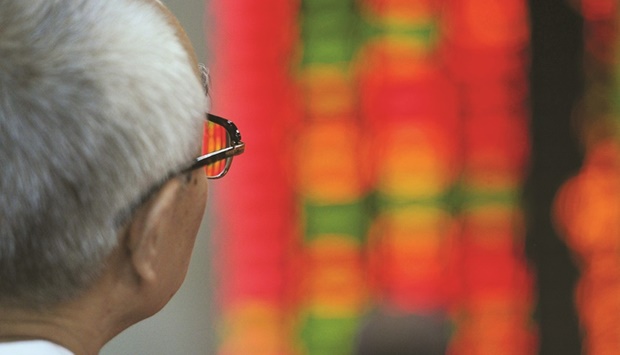The epicentre of global initial public offering activity has shifted east to China as waves of volatility and slumping stock markets have sent virtually all sizeable listings in the US into limbo.
Stock listings in Asia have raised $104bn this year, accounting for a record 68% of global volume, data compiled by Bloomberg show. By contrast, US IPOs represent just 14% of the $153bn fetched globally, the lowest ever for what has traditionally been the busiest listings market in the world.
The strong Asian showing is mostly down to Chinese IPOs, which have continued to come thick and fast even as rising interest rates and the prospect of a recession put a lid on first-time share sales in most major markets. Of the 10 largest listings globally this year, six were from Chinese companies either on mainland exchanges – the so-called A-share market – or in Hong Kong, the data show.
“In 2022, as the world deals with inflation and global tensions, the IPO epicentre in terms of volume has shifted east,” said James Wang, co-head of ECM at Goldman Sachs Group Inc, in Asia ex-Japan. “The continuity of such appears sustainable for the time being given some sizeable Hong Kong IPOs are lined up to potentially test markets before year end.”
In the US, which accounted for more than half of last year’s record $657bn of IPO proceeds, the market has come to a sudden halt as inflation fears and heightened volatility keep valuations depressed and cause investors to steer clear of the high-growth companies that typically dominate IPO activity.
The unwelcoming market conditions have forced highly anticipated listings like Mobileye NV and Chobani Inc to be pushed back or scrapped altogether. Until this week, there had been just $1bn-plus offering in New York this year, that of private equity firm TPG Inc.
In Asia there have been 12, while the Middle East has had four.
“We’re getting into the kind of market where people are just saying there’s capitulation,” said David Ethridge, US IPO services leader at PricewaterhouseCoopers LLP. “It’s happening right now. They’re busy people and maybe they don’t want to fight at the board level about getting the process started when we’re not hearing anything good about IPOs.”
The delayed US deals are compounding a void that was already being created by an exodus of IPO candidates based in China. Just $636mn has been raised in New York by companies from China or Hong Kong, compared to almost $16bn a year ago.
The slowdown in US IPOs by Chinese firms follows a run of delistings as Beijing and Washington worked to hash out an agreement on letting US regulators inspect Chinese companies’ audits, failing which they risked being kicked off American exchanges.
That prospect of forced delisting, as well as deteriorating Sino-US relations, prompted US-traded Chinese companies to raise tens of billions of dollars through so-called homecoming share sales in either Hong Kong or mainland exchanges in recent years. Higher valuations back home were another draw for them.
“The A-share market is somehow immune to the global volatility,” said Zili Guo, co-head of Asia equity capital markets at UBS Group AG. “It’s largely a domestic market, and mostly driven by domestic money. The market condition in the A-share market is relatively stable and, compared to the volatility we have seen in global markets, it can still print deals consistently.”
This year, some of Asia’s biggest listings were by companies that have been booted out of New York. China Mobile Ltd and CNOOC Ltd fetched a combined $14bn between them through their Shanghai share sales.
And there are signs of activity in Hong Kong, which had a slow first half. Chinese battery maker CALB Co is gauging demand for a potential $2bn IPO in the city, while electric-vehicle maker Zhejiang Leapmotor Technologies is looking to start taking investor orders for a $1 billion offering next week, Bloomberg News reported.
Even with a preliminary agreement on the auditing issue in the US, there are doubts that the flow of Chinese companies to New York – they have raised $122bn since the start of the century – will return to previous levels given ongoing tensions and increasing alternatives.
“Chinese issuers now have more options when they want offshore funding,” said Mandy Zhu, head of China, global banking at UBS. “Apart from the traditional HK and US listings, they can do an A-share IPO first.” Following that, the companies could tap European exchanges through a stock link between China and Europe, she said.
Indeed, Europe is becoming a more appealing listing venue for Chinese firms than the US. Some $2.3bn has been raised by mainland firms in Europe this year through the newly expanded stock link between China and exchanges in Germany, Switzerland and the UK, helping prop up dire listing volumes in the continent.
There is, of course, a mammoth deal around the corner in Europe, which could double the region’s current IPO proceeds of $9.8bn in one fell swoop. Porsche AG could kick off an offering as soon as this week that values the iconic sports-car maker at as much as €85bn ($85bn), Bloomberg News has reported.
And there are green shoots in the US as well. American International Group Inc’s life and retirement unit raised $1.68bn this week in the biggest US IPO this year after pricing its shares at the bottom of a marketed range. It’s being closely watched as a harbinger of better days to come, although it ended its first day of trading below the issue price.

An investor watches stock prices at a securities exchange in Shanghai. The strong Asian showing is mostly down to Chinese IPOs, which have continued to come thick and fast even as rising interest rates and the prospect of a recession put a lid on first-time share sales in most major markets.
